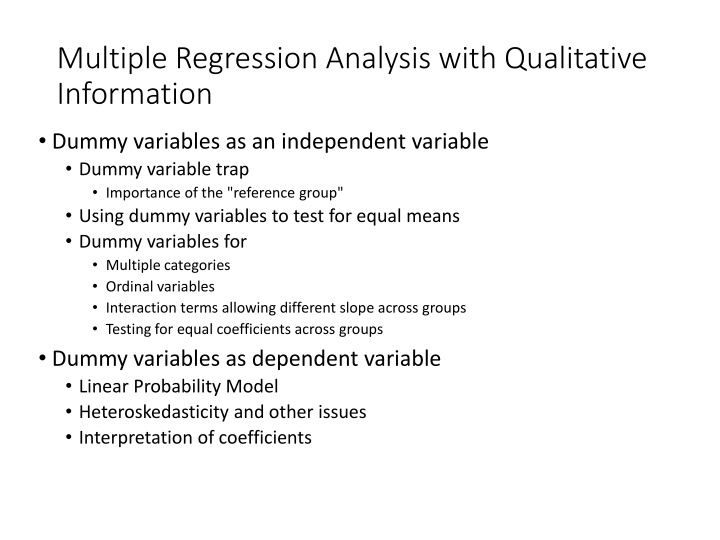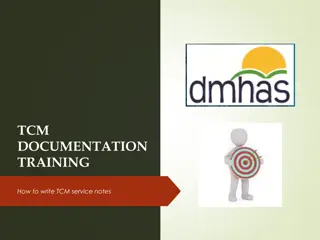
Multiple Regression Analysis with Dummy Variables
Explore the significance of dummy variables in multiple regression analysis, including their role as independent and dependent variables, dummy variable traps, interpretation of coefficients, and examples like wage differentials based on gender. Learn how dummy variables can be used to represent qualitative information and analyze data across multiple categories.
Download Presentation

Please find below an Image/Link to download the presentation.
The content on the website is provided AS IS for your information and personal use only. It may not be sold, licensed, or shared on other websites without obtaining consent from the author. If you encounter any issues during the download, it is possible that the publisher has removed the file from their server.
You are allowed to download the files provided on this website for personal or commercial use, subject to the condition that they are used lawfully. All files are the property of their respective owners.
The content on the website is provided AS IS for your information and personal use only. It may not be sold, licensed, or shared on other websites without obtaining consent from the author.
E N D
Presentation Transcript
Multiple Regression Analysis with Qualitative Information Dummy variables as an independent variable Dummy variable trap Importance of the "reference group" Using dummy variables to test for equal means Dummy variables for Multiple categories Ordinal variables Interaction terms allowing different slope across groups Testing for equal coefficients across groups Dummy variables as dependent variable Linear Probability Model Heteroskedasticity and other issues Interpretation of coefficients
Dummy variable as independent variable Dummy variables can be used to present qualitative information Examples: gender, race, industry, occupation, year, month, Can be measured with a set of "dummy variables" 1 if true; 0 if false Example: A single dummy independent variable = the wage gain/loss if the person is a woman rather than a man (holding education fixed) Dummy variable: =1 if the person is a woman =0 if the person is man
Dummy variable as independent variable Graphical Illustration Alternative interpretation of coefficient: i.e. the difference in mean wage between men and women with the same level of education. Intercept shift
Dummy variable trap ???? = ?0+ ?1???? + ?2?????? + ?3???? + ? The above model cannot be estimated because of perfect collinearity. male+female=1 and is perfectly collinear with intercept Infinite number of parameters yield same sum of squared errors no unique estimates that minimize SSE. To "fix" dummy variable trap, must omit one of the dummies or the intercept. ???? = ?0+ ?1?????? + ?3???? + ? ???? ?? ????????? ????? ???? = ?0+ ?1???? + ?3???? + ? ?????? ?? ????????? ????? ???? = ?0???? + ?0?????? + ?3???? + ? ?? ????????? ??? ???? ?0,?1, ?0,?1,??? ?0,?1 ????????
Wage equation as example. Estimated wage equation with intercept shift Holding education, experience, and tenure fixed, women earn $1.81 less per hour than men What would coefficient be if male dummy replaced female dummy? Intercept was dropped, but male & female dummies included? Does the above regression imply that women are discriminated against? Omitted variables bias Walmart class action gender discrimination case
Comparing means of subpopulations described by dummies Not holding other factors constant, women earn $2.51 per hour less than men, i.e. the difference between the mean wage of men and that of women is $2.51. Simple regression can be used to test whether whether difference in means is significant The wage difference between men and women is larger if no other things are controlled for Part of the difference in wages is due to differences in education, experience, and tenure between men and women -2.51 without controls vs -1.81 with controls
Dummy variables for treatment effects Effects of training grants on hours of training Hours training per employee Dummy variable indicating whether firm received a training grant This is an example of program evaluation Treatment group (= grant receivers) vs. control group (= no grant) Is the effect of treatment on the outcome of interest causal? Not if treatment is endogenous Treatment is endogenous if cov(treatment, error) 0
Dummy variables in log regressions. Using dummy explanatory variables in equations for log(y) Dummy indicating whether house is of colonial style As the dummy for colonial style changes from 0 to 1, the house price increases by 5.4 percentage points
Dummy variables for multiple categories 1) 2) Define membership in each category by a dummy variable Leave out one category (which becomes the base category or reference group) Could leave out intercept instead. 3) How would coefficients change if marrmale was made reference group? What hypotheses do t-statistics on dummies test?
Incorporating ordinal information using dummy variables Incorporating ordinal information using dummy variables Example: City credit ratings and municipal bond interest rates Credit rating from 0-4 (0=worst, 4=best) Municipal bond rate This specification would probably not be appropriate as the credit rating only contains ordinal information. A better way to incorporate this information is to define dummies: Other examples: Education groups Age groups Monthly or seasonal effects
Interactions involving dummy variables Interactions with dummies allow different slopes across groups. Interaction term example: = intercept men = slope men = intercept women = slope women Interesting hypotheses The return to education is the same for men and women The whole wage equation is the same for men and women
Interactions involving dummy variables Graphical illustration Interacting both the intercept and the slope with the female dummy enables one to model completely independent wage equations for men and women
Interactions involving dummy variables Estimated wage equation with interaction term Does this mean that there is no significant evidence of lower pay for women at the same levels of educ, exper, and tenure? No: this is only the effect for educ = 0. To answer the question one has to recenter the interaction term, e.g. around educ = 12.5 (= average education). No evidence against hypothesis that the return to education is the same for men and women
Testing for differences in regression functions across groups Unrestricted model (contains full set of interactions) High school rank percentile Standardized aptitude test score College grade point average Total hours spent in college courses Restricted model (same regression for both groups) F-test for equal regressions. How many degrees of freedom in numerator? Denominator?
Testing for differences in regression functions across groups All interaction effects are zero, i.e. the same regression coefficients apply to men and women Null hypothesis Estimation of the unrestricted model Tested individually, the hypothesis that the interaction effects are zero cannot be rejected
Multiple Regression Analysis with Qualitative Information Joint test with F-statistic Null hypothesis is rejected Chow test: alternative way to compute F-statistic in the given case Run separate regressions for men and for women; the unrestricted SSR is given by the sum of the SSR of these two regressions Run regression for the restricted model and store SSR Important: Test assumes a constant error variance accross groups
The linear probability model Linear regression when the dependent variable is binary If the dependent variable only takes on the values 1 and 0 Linear probability model (LPM) In the linear probability model, the coefficients describe the effect of the explanatory variables on the probability that y=1
The linear probability model Example: Labor force participation of married women =1 if in labor force, =0 otherwise Non-wife income (in thousand dollars per year) If the number of kids under six years increases by one, the pro- probability that the woman works falls by 26.2% Does not look significant (but is it "exogenous" i.e. Cov(kids, error)=0?
Multiple Regression Analysis with Qualitative Information Example: Female labor participation of married women (cont.) Graph for nwifeinc=50, exper=5, age=30, kindslt6=1, and kidsge6=0 The maximum level of education in the sample is educ=17. For the gi-ven case, this leads to a predicted probability to be in the labor force of about 50%. Negative predicted probability but no problem because no woman in the sample has educ < 5.
Multiple Regression Analysis with Qualitative Information Disadvantages of the linear probability model Predicted probabilities may be larger than one or smaller than zero Marginal probability effects sometimes logically impossible The linear probability model is necessarily heteroskedastic Variance of Ber- noulli variable Heteroskedasticity consistent standard errors need to be computed Advantanges of the linear probability model Easy estimation and interpretation Estimated effects and predictions are often reasonably good in practice
Multiple Regression Analysis with Qualitative Information More on policy analysis and program evaluation Example: Effect of job training grants on worker productivity The firm s scrap rate =1 if firm received training grant, =0 otherwise No apparent effect of grant on productivity Treatment group: grant receivers, Control group: firms that received no grant Grants were given on a first-come, first-served basis. This is not the same as giving them out randomly. It might be the case that firms with less productive workers saw an opportunity to improve productivity and applied first.
Multiple Regression Analysis with Qualitative Information Self-selection into treatment as a source for endogeneity In the given and in related examples, the treatment status is probably related to other characteristics that also influence the outcome The reason is that subjects self-select themselves into treatment depending on their individual characteristics and prospects Experimental evaluation In experiments, assignment to treatment is random In this case, causal effects can be inferred using a simple regression The dummy indicating whether or not there was treatment is unrelated to other factors affecting the outcome.
Multiple Regression Analysis with Qualitative Information Further example of an endogenous dummy regressor Are nonwhite customers discriminated against? Dummy indicating whether loan was approved Race dummy Credit rating It is important to control for other characteristics that may be important for loan approval (e.g. profession, unemployment) Omitting important characteristics that are correlated with the non-white dummy will produce spurious evidence for discrimination






















